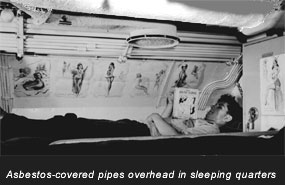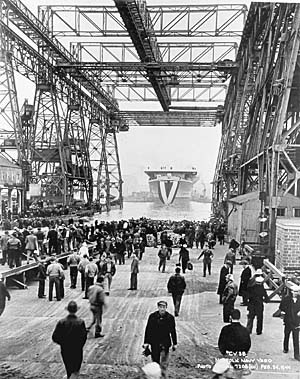Shipyard Asbestos Exposure
Today, thousands of former shipyard workers and veterans are contracting mesothelioma. Why? Because of the Navy’s use of asbestos in ships.
Its ability to withstand high temperatures and corrosion made asbestos an ideal material for insulating the vessels’ heat-producing components in warships.
During much of the 20th Century, especially during World War II and the early Cold War years, large quantities of  asbestos went through shipyards into new ships and out of refurbished and decommissioned ships. Thousands of shipyard workers breathed the fine asbestos fibers.
asbestos went through shipyards into new ships and out of refurbished and decommissioned ships. Thousands of shipyard workers breathed the fine asbestos fibers.
In fact, based purely on fatality statistics, working in an American shipyard during World War II was almost as deadly as fighting in the war.
During World War II, 16.1 million Americans were called to arms. The combat death rate was about 18 per thousand service members. About 4.3 million Americans worked in shipyards during the war. For every thousand wartime shipyard employees, about 14 died of asbestos-related cancer, and an unknown number died of asbestosis or complications from it.
It is well documented that the civilian asbestos industry concealed the dangers of asbestos and misled the public and its own workers. The asbestos industry’s cover-up did not keep the truth from federal health officials, among them Navy doctors and other government health experts. Naval medical authorities were aware that asbestos posed a danger early on.
A Navy medical bulletin published in 1922 listed asbestos work as a hazardous occupations and suggested that respirators be used in the workplace.
Late 1930s handbooks  for Navy medical corpsmen discussed the hazards asbestos workers faced. In 1941 the Navy’s chief officer for preventive medicine wrote of asbestos workers in shipyards: ``I am certain that we are not protecting the men as we should.”
for Navy medical corpsmen discussed the hazards asbestos workers faced. In 1941 the Navy’s chief officer for preventive medicine wrote of asbestos workers in shipyards: ``I am certain that we are not protecting the men as we should.”
The Navy was clearly aware of the problem, and at the height of the wartime shipbuilding effort in 1943, it issued a document specifying “Minimum Requirements for Safety and Industrial Health in Contract Shipyards.” These standards regulated asbestos work in all yards that built or repaired Navy ships. They required the segregation of dust-producing jobs and special ventilation of dusty areas, and mandated that asbestos workers wear respirators and receive periodic medical examinations. The shipyards were expected to enforce those standards.
Years later, a World War II era Navy industrial health officer testified that the Navy could have built ships during the war in ways that would have minimized health risks. But the military establishment chose to ignore breaking the rules in order to maintain high production levels.
A 1984 medical survey of shipyard workers at Norfolk Naval Shipyard in Portsmouth showed that an incredible 79 percent exhibited signs of lung abnormalities consistent with asbestos exposure. X-rays given to 90 wives of shipyard workers revealed that eight, or 9 percent, showed similar abnormalities.
Investigators have shown that the Navy dragged its feet in removing asbestos from its ships and in finding alternatives. The Navy was concerned more about money, viable asbestos alternatives, and military preparedness. The Navy used 298 asbestos-containing products in its ships, and it would take years, and millions of dollars, to safely remove and replace the insulation material from the fleet.
Now, decades after these shipbuilders and navy veterans served their country, many are being stricken with deadly mesothelioma. Have you or a member of your family have been diagnosed with mesothelioma? Contact us for help.
